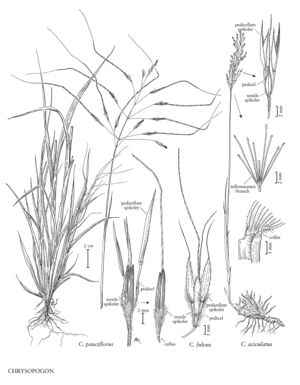Difference between revisions of "Chrysopogon pauciflorus"
FNA>Volume Importer |
imported>Volume Importer |
||
| Line 39: | Line 39: | ||
|publication year= | |publication year= | ||
|special status= | |special status= | ||
| − | |source xml=https:// | + | |source xml=https://bibilujan@bitbucket.org/aafc-mbb/fna-data-curation.git/src/bb6b7e3a7de7d3b7888a1ad48c7fd8f5c722d8d6/coarse_grained_fna_xml/V25/V25_1540.xml |
|subfamily=Poaceae subfam. Panicoideae | |subfamily=Poaceae subfam. Panicoideae | ||
|tribe=Poaceae tribe Andropogoneae | |tribe=Poaceae tribe Andropogoneae | ||
Revision as of 22:02, 27 May 2020
Plants annual. Culms 60-110 cm, erect or somewhat decum¬bent. Sheaths glabrous; ligules membranous, ciliolate; blades to 31 cm long, 4-10 mm wide, flat or folded, mostly or completely glabrous, adaxial surfaces some¬times with scattered pubescence at the base. Panicles 20-30 cm, open; branches 5-8 cm, capillary, strongly divergent; rames usually a triplet of spikelets. Sessile spikelets 8.1-10 mm; calluses about 7 mm, sharp; glumes smooth below, scabrous distally; lower glumes shortly awned or mucronate from the sinuses of the minutely bilobed apices; upper lemmas awned, awns 10.6-16 cm, geniculate, twisted below. Pedicellate spikelets 7.2-15 mm. 2n = unknown.
Distribution
N.C., Fla., Tex.
Discussion
Chrysopogon pauciflorus is native, but infrequently encountered, in the southeastern United States, primarily in Florida; it also occurs in Cuba. It grows in flatwoods, abandoned fields, pinelands, marsh edges, and various disturbed sites.
Selected References
None.
